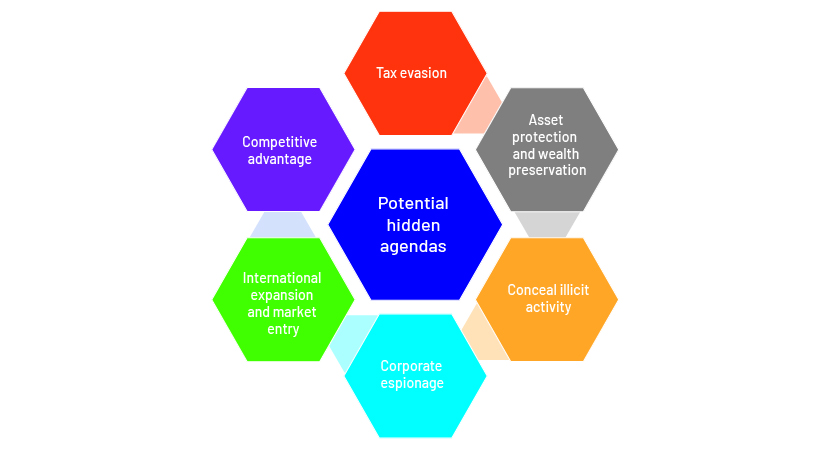Published on May 30, 2024 by Anisha Shangari
In the intricate world of corporate structures and financial transactions, the concept of beneficial ownership often lurks in the shadows, shrouded in opacity and complexity. While legitimate business interests may drive some of these arrangements, there is growing concern about the misuse of fictitious beneficial ownership to conceal illicit activity, evade taxes and facilitate money laundering. In this blog, we delve into how companies hide beneficial ownership, the risks associated with such practices and the laws being implemented to combat them. The following image illustrates a company’s motives for using a fictious ownership structure:

The use of fictitious beneficial ownership is not limited to specific cases; it occurs across jurisdictions and businesses. For example, the 2021 Pandora Papers leak exposed the widespread use of multiple holders to facilitate variety ownership, affecting many high-profile individuals and companies (click here to read our blog on this).
Unveiling the shadows: how companies hide beneficial ownership
-
Shell companies: This is one of the most common methods. These entities, often with little to no legitimate business activity, serve as a vehicle to obscure actual ownership.
-
Jurisdictional arbitrage: Exploiting regulatory loopholes and setting up entities in jurisdictions with lax disclosure requirements enable companies to shield beneficial ownership from scrutiny.
-
Complex ownership structures: Elaborate ownership structures involving multiple layers of subsidiaries, trusts and offshore accounts can conceal the ultimate beneficiaries behind a web of legal entities.
-
Nominee directors and shareholders: Companies may employ nominee directors or shareholders to hold legal title to assets on behalf of the true beneficial owners, effectively masking their involvement.
Risks of fictitious beneficial ownership
-
Money laundering: Concealing the true ownership of assets facilitates the integration of illicit funds into the legitimate financial system, enabling money laundering on a large scale.
-
Terrorist financing: Terrorist organisations may exploit loopholes in beneficial ownership regulations to finance their operations, posing a significant threat to national security.
-
Tax evasion: By disguising the true beneficiaries of income and assets, companies tend to evade taxes in their home jurisdictions.
-
Corruption and fraud: Fictitious beneficial ownership provides fertile ground for corruption and fraudulent activity as bad actors exploit the anonymity afforded by opaque corporate structures.
Shedding light: laws to combat fictitious beneficial ownership
-
The US Department of the Treasury’s Financial Crimes Enforcement Network (FinCEN) launched the Beneficial Ownership Registry in January 2024. Companies have time until January 2025, and new companies created in 2024 have 90 days from the date of incorporation, to file details of beneficial ownership: https://www.fincen.gov/news/news-releases/us-beneficial-ownership-information-registry-now-accepting-reports
-
The Financial Action Task Force (FATF) helps combat cross-border money laundering and terrorist-financing schemes.
-
In March 2022, the FATF agreed on tougher global beneficial ownership rules to stop criminals from hiding their illicit activities and dirty money behind secret corporate structures: https://www.fatf-gafi.org/en/publications/Fatfrecommendations/Guidance-Beneficial-Ownership-Legal-Persons.html
-
-
According to regulations stipulated by the European Union's Fifth Anti-Money Laundering Directive, member states need to ensure that they compile central registers of beneficial ownership information accessible to competent authorities and obliged entities.
Conclusion
Fictitious beneficial ownership significantly tests the integrity of the global financial system, enabling a range of illicit activities while undermining transparency and accountability. However, concerted efforts by regulatory bodies, financial institutions and governments to enhance transparency, enforce regulations and foster international cooperation offer hope in the ongoing fight against financial crime.
How Acuity Knowledge Partners can help
We ensure that we unwrap ownership of a company without a pre-defined threshold; our objective is to identify risk in ownership, which is often missed if pre-defined thresholds are applied. We rate a company’s risk using multiple parameters, with ownership structure and corresponding jurisdictions playing important roles. The following are some of the key areas we focus on when reviewing ownership details:
-
Excessive complexity in the ownership structure
-
High use of shell companies
-
Presence of jurisdictions known for their lack of transparency
-
Changes in ownership patterns, such as a sudden transfer of shares or the appearance of nominee shareholders
Sources:
Tags:
What's your view?
About the Author
Anisha Shangari is a Delivery Manager at Acuity Knowledge Partners, with her experience spanning 9.5 years. At Acuity, she oversees engagements related to enhanced due diligence with a focus on identifying risks and assessing measures to mitigate the same. Prior to Acuity, she worked at American Express in the areas of risk management, specifically in fraud detection. Anisha's professional journey is anchored by her academic achievements, including a Master's degree in Mathematics from the University of Delhi, augmented by a Six Sigma Green Belt certification from The Indian Institute of Statistics.
Like the way we think?
Next time we post something new, we'll send it to your inbox








